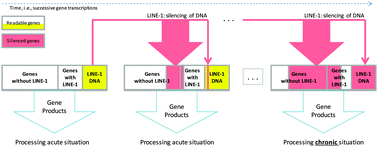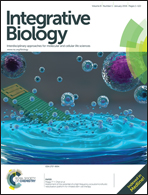A computational functional genomics based self-limiting self-concentration mechanism of cell specialization as a biological role of jumping genes†
Abstract
Specialization is ubiquitous in biological systems and its manifold mechanisms are active research topics. Although clearly adaptive, the way in which specialization of cells is realized remains incompletely understood as it requires the reshaping of a cell's genome to favor particular biological processes in the competition on a cell's functional capacity. Here, a self-specialization mechanism is identified as a possible biological role of jumping genes, in particular LINE-1 retrotransposition. The mechanism is self-limiting and consistent with its evolutionary preservation despite its likely gene-breaking effects. The scenario we studied was the need for a cell to process a longer exposition to an extraordinary situation, for example continuous exposure to the nociceptive input or the intake of addictive drugs. Both situations may evolve toward chronification. The mechanism involves competition within a gene set in which a subset of genes cooperating in particular biological processes. The subset carries a piece of information, consisting of the LINE-1 sequence, about the destruction of their functional competitor genes which are not involved in that process. During gene transcription, an active copy of LINE-1 is co-transcribed. At a certain low probability, a subsequently transcribed and thus actually exposed gene can be rendered nonfunctional by LINE-1 retrotransposition in a relevant gene part. As retrotransposition needs time it is unlikely that LINE-1 retrotranspose into its own carrier gene. This reshapes the cell genome toward self-specializing of those biological processes that are carried out with a high number of LINE-1 containing genes. Self-termination of the mechanism is achieved by allowing LINE-1 to also occasionally jump into the coding region of itself, thus destroying the information about competitor destruction by successively decreasing the number of LINE-1 until the mechanism ceases. Employing a computational functional genomics approach, we demonstrate the biological plausibility in functional genomic datasets of potentially chronifying situations and interpret our results in relation to a biological mechanism of self-specialization of complex systems in response to a persistent challenge as met in chronifying traits.


 Please wait while we load your content...
Please wait while we load your content...